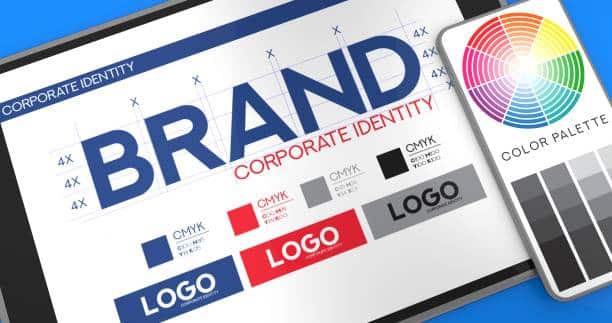Having a strong and reliable brand is a precious asset for any business in the current marketplace. However, it can be a challenging task to maintain a consistent brand, especially when working with a diverse team. Therefore, it is necessary to have brand guidelines to ensure brand consistency and coherence.
To effectively create brand guidelines, you must first understand what they mean and why it is necessary for your business to have one. Also, you’ll learn how to create a guide to position your brand and business for success.
What is a Brand Guideline?
Brand guidelines, also referred to as brand style guides, are essential documents that establish and regulate the overall appearance and ambiance of your brand.
Furthermore, these guidelines provide a framework for consistency and cohesiveness across all branding elements, including visual and written communication.
They assist in the development of a brand identity that your target market can identify across all channels. The guidelines communicate important details about the company, which include its tone, voice, messaging, and visuals.
Branding guidelines provide a document that anybody inside or outside of your business can consult if they have questions about how to use your brand’s colors, typefaces, and other elements.
The Purpose of Brand Guidelines
Brand guidelines create a brand identity that stands out from competitors and enables customers to easily identify it as their main purpose. They ensure accurate communication of the brand’s image, both internally and to the audience.
Companies give extra attention to creating brand guidelines and applying them to ensure that the image of the brand remains consistent across various platforms; this builds familiarity, reliability, and brand loyalty amongst customers.
Why You Need Brand Guidelines
As a business owner, creating a brand guideline is very important. Here are some reasons you should create one;
- It gives your brand consistency that customers can respond to
- Having a brand guideline makes your brand stand out from the crowd
- It boosts customer loyalty
- It gives the team more efficiency
- Brand guidelines make the brand more tangible
The 4 Key Elements of a Brand Guideline
#1. Brand Identity
Your desired brand perception is reflected in your brand identity. It’s critical that you understand your brand identity and the direction you want it to take.
Lacking a distinctive brand identity will make it difficult for you to build brand awareness. To establish a brand identity, first identify your mission. Then, create a visual identity and unique value proposition. Finally, work on increasing brand recognition.
#2. Brand Image
A brand’s image is the perception that people have of it based on its reputation, visual identity, messaging, and overall presence.
It can influence consumer behavior and loyalty, and is crucial for building trust and differentiation in a competitive market.
For brand’s image, utilize social media platforms, post high-quality material that accurately reflects the image you want the audience to have of your company, and consider redesigning your website to create a brand identity.
#3. Brand Culture
A brand’s culture encompasses the values, beliefs, and behaviors that define its internal and external operations.
It influences how employees work and how customers perceive the brand. A strong culture can lead to better employee engagement, customer satisfaction, and business performance.
#4. Brand Personality
Developing a brand personality is a way of relating to your customer base on an emotional basis. It can be seen as the human characteristics that can be attributed to a brand.
A brand’s personality is seen in the company’s marketing campaign, its imaging and brand messaging. Understanding who your audience is and engaging with the audience in a consistent tone and approach is vital in creating a brand personality.
Creating a Brand Style Guide
#1. Brand Story
Good startup stories are popular because they captivate audiences. For the customers, being open about your beginnings and the reasons you launched your business will help them connect with the brand.
A brand story identifies and explains the things that matter most to a company and its core values. Decision-making within an organization becomes easier as they follow the brand story’s guidance.
Brand stories are a company’s way of unifying its vision, mission, and core values. The brand story should always come first in a brand style guide. It sets the stage for the brand experience and should inform the rest of the style guide.
#2. Brand Logo
The brand logo is the next essential aspect of your brand style guide. A logo serves to represent your brand and is a visual representation of its core message. It mostly includes a name, a symbol, or specific colors.
The uniqueness of the brand logo comes from the logo being universally applicable, easily recognizable, and identifiable.
These guides specify the proper way to use their logos, providing guidelines for the amount of space to be left around their logos, each logo color that is appropriate, and the minimum logo size.
Your established brand story might provide inspiration for developing your brand logo. You might incorporate any visual elements from the story or perhaps the symbols that represent the personality of your company.
#3. Color Palette
A brand’s color palette consists of the primary and secondary hues that will be used to create the brand’s visual identity. Clearly state your brand’s color scheme in your brand style guide, as the color palette in the style guide will direct your visual elements and be utilized in everything design-related.
Color schemes can be low-key but quite effective, it doesn’t really matter whether you have one primary brand color or some secondary shades; people respond to color. So, when used correctly, it can evoke particular emotions, set tone, define emphasis, and so much more. By making brand colors well known through consistent use, the recognition of the brand will be intact.
Include your primary brand colors with hex codes and RGB values in your brand style guide, as well as relevant shade variations and some current dos and don’ts. Creating a significant association between your brand and the brand’s color palette will enable your brand to be easily recognized on social media and websites.
#4. Typography
Typography is one aspect of brand styling that sometimes gets overlooked, as there are not necessarily good or bad font typefaces for a brand. Rather, there are appropriate and inappropriate typefaces with regards to what you want your brand to communicate. Using inappropriate typefaces can cheapen your brand and communicate things that shouldn’t be communicated.
Each type has its own unique shape, personality, character, and texture; it can even express a particular mood. When used properly, it might go unnoticed but will look bad when used incorrectly. It’s important to think of typography less as words on the page and more as a graphic element and illustration; it can be considered an art form.
To enhance your brand experience, use a brand style guide to ensure you’re applying typography consistently across your collateral. This means outlining what fonts are used for what purposes (in print and on the web).
#5. Brand Voice
Establishing a brand voice is necessary because it impacts how your audience feels about you. While brand image is established by the brand’s color and typography, brand voice gives the brand a personality and attitude.
How do you want your customers to feel about your brand? What is the personality of your brand? Setting a tone of voice will fix this
Understanding your desired tone of voice can help you communicate effectively with your audience and establish your brand’s voice across all your messaging on different platforms. It’s key to have a single voice so that all of your communications, regardless of who is writing them, are consistent.
You shouldn’t underestimate the significance of using a consistent brand voice in your messaging. Find the style that appeals to your audience and probably fits the personality of your brand
#6. Image Guidelines
Think about the perception you want people to have of your brand; it will be vital in choosing the visuals in the imagery section of your brand guidelines. The imagery section in your brand guidelines will show a series of images, including style and color, and will communicate the look and feel you want your brand to assume.
Create some guidelines for imagery to include in your brand style guide. The image guidelines will also dictate the physical look you are going for. This will be useful in creating your website and marketing materials, social media feeds, and photo and video production.
Tips on Creating Brand Guidelines
The goal of creating brand guidelines is to create brand recognition and maintain the integrity of your brand. Below are tips to help you build your brand guidelines that will elevate the perception of your brand in the minds of your customers.
- Establish the goal for your brand guidelines
- Define your audience
- Select a format for your brand guideline
- Determine the elements that your brand guidelines will contain
- Define specific usage rules
- Collect the necessary identity elements
- Create the guidelines
- Carry out brand training and distribute the guidelines to your audience
What Brand Guideline Should Include
Your brand guidelines should include the following;
- Your brand guideline should include your brand’s history, mission, core values, and vision
- Include guidelines on logo usage including color palette, file format, minimum and maximum sizes, contexts, spacing, and usage permissions
- The brand’s color palette which should include RGB and CMYK codes
- Fonts and text sizes (both print and digital)
- Brand’s tone of voice and grammar rules
- Imagery, icons, design elements and photography
10 Brand Guidelines Examples to Inspire Your Brand Style Guide
- Nike – Nike’s brand guidelines are well-known for their simplicity and consistency, with a focus on bold typography and the iconic Nike swoosh.
- Coca-Cola – Coca-Cola’s brand guidelines emphasize the importance of the company’s signature red and white colors, as well as its iconic script logo.
- Apple – Apple’s brand guidelines prioritize a clean, minimalist aesthetic, with a focus on sleek typography and high-quality imagery.
- Google – Google’s brand guidelines focus on simplicity and user-centric design, with a focus on playful illustrations and bright, primary colors.
- Airbnb – Airbnb’s brand guidelines prioritize a warm, inviting aesthetic, with a focus on bold typography and a variety of colors and patterns.
- Dropbox – Dropbox’s brand guidelines emphasize the importance of clean, simple design, with a focus on whitespace and minimalist typography.
- Spotify – Spotify’s brand guidelines prioritize a bold, colorful aesthetic, with a focus on vibrant gradients and playful typography.
- Starbucks – Starbucks’ brand guidelines emphasize the importance of the company’s signature green color, as well as its iconic siren logo.
- IBM – IBM’s brand guidelines prioritize a clean, professional aesthetic, with a focus on minimalist typography and a blue color scheme.
- Twitter – Twitter’s brand guidelines prioritize a simple, clean aesthetic, with a focus on the company’s signature blue color and minimalist typography.
What Determines Your Brand Guidelines?
Depending on resources, existing structure, and brand objectives, each company has a different timetable for determining brand guidelines. For organizations, determining what should be in the brand book calls for a clear understanding of what your brand represents and how the new guidelines are applied. How to determine your brand guidelines are as follow;
- Establish what your brand essence is. This forms the foundation of your brand guideline.
- Develop the rules on how to use the elements of the style guide (logo, typography etc.)
- Communicate the guideline to your team and train them on how to use them
- Keep in mind that businesses grow and change and as they do, the guidelines evolve as well.
The Six Most Important Elements of a Brand Style Guide
The six essential elements of a brand style guide that make up the brand guidelines are: the brand story, the logo, the color palette, typography, image guidelines, and tone of voice.






